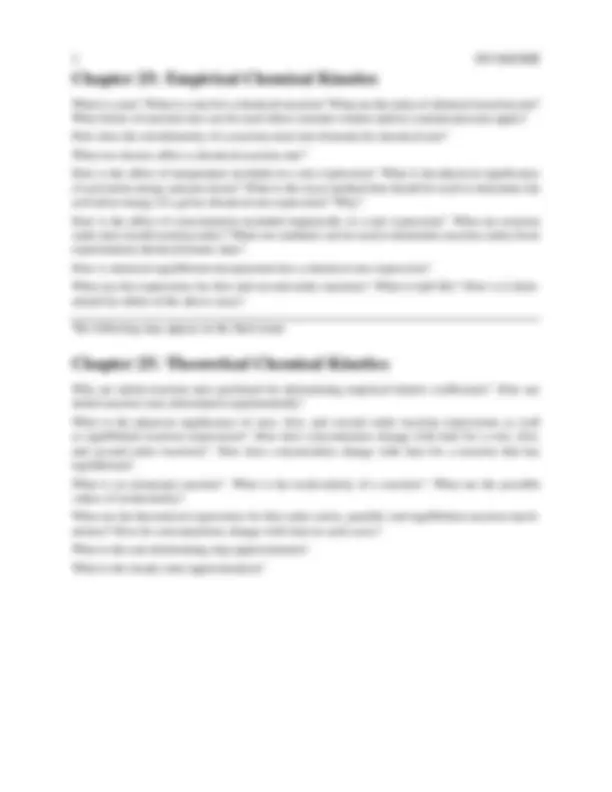



Study with the several resources on Docsity

Earn points by helping other students or get them with a premium plan


Prepare for your exams
Study with the several resources on Docsity

Earn points to download
Earn points by helping other students or get them with a premium plan
Community
Ask the community for help and clear up your study doubts
Discover the best universities in your country according to Docsity users
Free resources
Download our free guides on studying techniques, anxiety management strategies, and thesis advice from Docsity tutors
This study guide provides information on how to prepare for the ch 342 course during spring 2002. It covers topics such as gas dynamics, gas transport processes, and empirical and theoretical chemical kinetics. Students are encouraged to work homework problems backward and forward, review similar exercises, and be prepared for short essay questions and numerical calculations. Key concepts include the kinetic model of gases, collision flux, transport coefficients, and chemical reaction rates.
Typology: Assignments
1 / 2

This page cannot be seen from the preview
Don't miss anything!


CH 342/Spring 2002 April 15, 2002
For the following, when a question asks how something is determined, it means how would it be established in an experiment, how would it be calculated using its defining equation, or how would it be used in its defining equation or other related equations.
Know how to work the homework problems backward and forward. Review similar exercises and problems in the textbook to those given as homework assignments. Review all example problems in the textbook. Be prepared to answer short essay questions (with a few sentences) and to do prob- lems involving numerical calculations with the equations given. Be prepared to perform general derivations using algebraic manipulations of formulations and principles in calculus (differentia- tion, partial differentiation, and integration).
What is the kinetic model of gases? What assumptions are used in its derivation?
Given a distribution of speeds f ( v ), how are the mean, rms, and most probable speeds of calculated mathematically?
What is the meaning of the relative speed? How is it determined for a pure gas? How is it deter- mined for two dissimilar gas molecules?
How are the mean, rms, and most probable speeds affected by pressure, temperature, and molar mass of a gas?
What is the shape of the Maxwell distribution of speeds at different temperatures for different gas molecules? What do the mean, rms, and most probable speeds of molecules represent on the distribution?
What is the physical significance of collision frequency and mean free path? How are they affected by pressure, temperature, and molar mass of a gas?
What is the significance of collision flux? How is it affected by pressure, temperature, and molar mass of a gas?
What are the three transport coefficients of a fluid? What are their typical SI or other units? What are the typical orders of magnitudes of transport coefficients for gases? How are they affected by pressure, temperature, and molar mass of a gas?
What does the Poiseuille’s formula provide? How do the parameters of pressure, tube diameter, and viscosity enter in the formula? How is volumetric flow affected by these parameters?
What is a rate? What is a rate for a chemical reaction? What are the units of chemical reaction rate? What forms of reaction rate can be used when constant volume and/or constant pressure apply?
How does the stoichiometry of a reaction enter into formula for chemical rate?
What two factors affect a chemical reaction rate?
How is the affect of temperature included in a rate expression? What is the physical significance of activation energy and pre-factor? What is the exact method that should be used to determine the activation energy of a given chemical rate expression? Why?
How is the affect of concentration included empirically in a rate expression? What are reaction order and overall reaction order? What two methods can be used to determine reaction orders from experimental chemical kinetic data?
How is chemical equilibrium incorporated into a chemical rate expression?
What are the expressions for first and second order reactions? What is half life? How is it deter- mined for either of the above cases?
The following may appear on the final exam.
Why are initial reaction rates preferred for determining empirical kinetic coefficients? How are initial reaction rates determined experimentally?
What is the physical significance of zero, first, and second order reaction expressions as well as equilibrium reaction expressions? How does concentration change with time for a zero, first, and second order reactions? How does concentration change with time for a reaction that has equilibrium?
What is an elemental reaction? What is the molecularity of a reaction? What are the possible values of molecularity?
What are the theoretical expressions for first order series, parallel, and equilibrium reaction mech- anisms? How do concentrations change with time in such cases?
What is the rate determining step approximation?
What is the steady-state approximation?